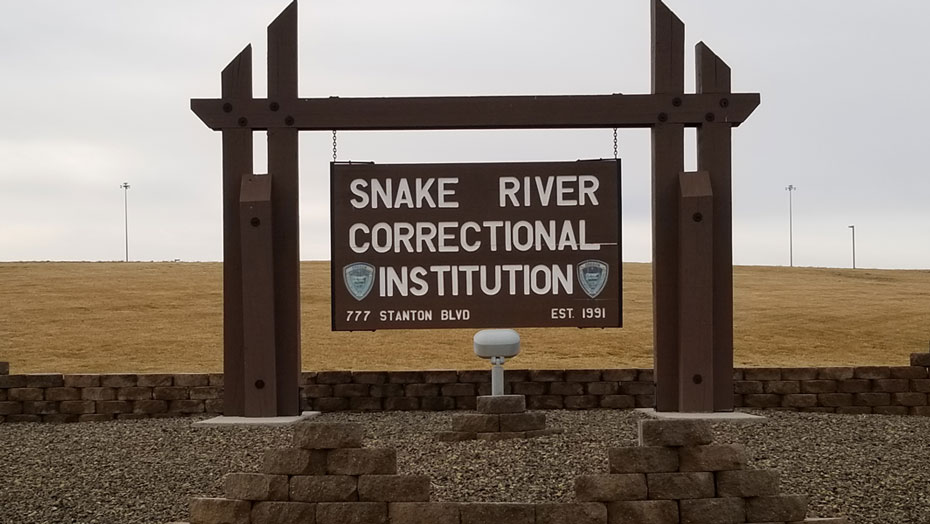
The state’s largest prison began a new policy on segregated housing a year ago and since then inmate-to-inmate assaults are down. (The Enterprise/Pat Caldwell).
ONTARIO – A year ago, the cell on the upper tier of Snake River Correctional Institution’s privileged housing unit was stark.
The cell was once part of the prison’s intensive management unit, meant for inmates who were deemed too dangerous or too big a security risk to mix with the rest of the prison population.
It was, simply, “the hole.”
As such it was a barren space measuring roughly 12 by 7 with a metal bunk bed and a stainless-steel sink and toilet its only fixtures.
Today, that same cell has bookshelves and a small desk packed with knick-knacks like shaving and skin cream, animal figurines and pens and pencils. A small TV dangles over each of the two bunk beds in the cell. Inmate clothing droops from hangers near the big heavy cell door.
The change is part of a pioneering program to move away from placing inmates in special segregated housing at the state’s largest prison. As part of that move, last year Snake River slashed its number of what are known as intensive management unit cells. The new approach is a leap away from what was once considered a reliable and effective method to maintain discipline but is now is viewed as an antiquated and ineffective policy.
The Oregon Department of Corrections classifies special inmate housing in five categories: Administrative housing, administrative segregation, disciplinary segregation, intensive management and mental health special housing.
Life in an administrative housing unit is much like the general population. Inmates are often placed in administrative housing for their own protection and not because they violated prison rules.
Administrative and disciplinary segregation and intensive management are reserved for inmates who commit serious rule violations.
“This could include staff assault, assaulting another inmate, drug possession and disrespecting a staff member,” said Amber Campbell, Snake River public information officer. Campbell said an inmate can also be sent to a special housing unit if he is found in an unauthorized area of the prison.
Also, an inmate involved in a major disruption – such as plotting and executing a riot – will be assigned to the intensive management unit.
An inmate in an intensive management unit has few privileges and is monitored far more than an inmate in the general population or administrative and disciplinary segregation.
In the intensive management unit, an inmate spends most of his day in his cell. They are allowed to come out five days a week to the recreation yard for 40 minutes and get a 20-minute shower. The main difference between inmates in an intensive management unit cell and those in the general population is freedom of movement.
“Inmates in the general population go to work, meals, education and other daily activities. Inmates in special housing have all of their meals delivered to them and are restrained everywhere they move,” said Campbell.
Snake River is the only prison in the state with an intensive management unit for men.
That means prisons across Oregon send their most severe discipline cases to the Snake River.
Major Shift.
Research shows, though, that a long-term stay in an intensive management unit – and all segregated housing – doesn’t improve inmate behavior or make prisons safer.
That’s why last year Snake River, which holds 2,990 inmates, switched 72 of its intensive management cells to use by the prison’s general population. Now Snake River contains 168 intensive management unit cells – down from 240 previously.
“We have all seen the research over the last 10 years that talks about the physiological and psychological effects of putting people in long-term isolation,” said Judy Gilmore, assistant superintendent at Snake River.
Vera Institute of Justice, a national nonprofit research and policy organization, reported in 2015 that while segregated housing may be necessary in some cases, isolating inmates can “damage, sometimes irreparably, the people thus confined and the communities to which they return.”
The report said, “The characteristics that define segregated housing – social isolation, reduced environmental stimulation, and loss of control over all aspects of daily life – create a ‘potent mix’ that produces a litany of negative impacts.”
That includes hallucinations, increased anxiety and nervousness, diminished impulse control and severe and chronic depression, the report said.
The potential impact on communities – where inmates are released when their sentences are finished – is a big factor in the switch, said Gilmore.
“Since 95 percent of the inmates go back to their communities, we don’t want something to happen to them. We are working hard to create better neighbors, not better prisoners,” said Gilmore.
Budget constraints also played a role, said Gilmore.
“It does cost more money to run those units. You have to have multiple staff to put restraints on inmates and have staff escort them to get services,” said Gilmore.
Reducing the number of intensive management unit cells avoids future costs, said Jason Bell, the prison’s assistant superintendent of security.
“We don’t have to put more money out to build more prisons,” said Bell.
Another aim of reducing the number of intensive management unit cells, said Campbell, is not to punish but to rehabilitate an inmate.
“We want a functional person to leave here. These folks will be shopping in the grocery stores and living next to us, so what kind of person do you want them to be?” said Campbell.
Campbell said “re-teaching” inmates to be less violent is a long-term practice.
“A lot of these guys haven’t had a role model so some of it is teaching them day to day ‘This is how you deal with conflict.’ We have programs that address that,” said Campbell.
The prison also changed some of its discipline rules to limit the need for segregated housing.
“We are trying to do informal methods of progressive discipline. A few years back we changed the rules in the way we hand out informal discipline where staff can assign an inmate to a cell with the approval of their supervisor in lieu of putting them into segregation,” said Bell.
Bell said prison workers are trying to “fit the punishment to the crime” and that often means instead of a trip to a segregated cell, an inmate will lose their access to electronics, such as a television.
Gilmore said focusing on rehabilitation instead of sanctions works.
“If there are alternative ways to hold people accountable it is better for the community,” said Gilmore
Gilmore said there remains a need for segregated housing.
“Sometimes if you have a fight you need to separate people and separate them from the general population to investigate,” said Gilmore. “We are always going to run a safe and secure facility. Using special housing beds to keep people safe is a component of that.”
The key, said Gilmore, is a measured response to infractions.
“You want to use (segregated housing) judiciously and for short periods of time whenever possible,” said Gilmore.
For decades segregated housing was viewed as essential for safety of inmates and corrections officers but data from Vera showed there was little evidence to support the notion isolating inmates helped security.
Widespread use of segregated housing fails “to make prisons and jails any safer for those incarcerated or for the people who work in them,” said the Vera report.
Cutting the number of inmates in segregated housing works, said Capt. Thomas Jost, who oversees the prison’s special housing unit.
Jost said there was a noticeable change in inmate behavior after the prison made the shift. Inmates became less violent, he said.
Jost said there was skepticism among some corrections officers early on regarding the new policy. They are now believers, he said.
Jost said since the prison started its new policy, “staff assaults are down and inmate-to-inmate assaults are down. It worked well. It was nice to see the change,” said Jost.
The Vera report also showed that the policy works in other states. For example, more than 10 years ago, the Vera report said, Colorado dropped its use of segregated housing by 85 percent and inmate-to-staff assaults remained low.
Gilmore said the Corrections Department is focused on rehabilitation, not punishment, of inmates.
“We want to hold inmate accountable but reduce the risk of them coming back to prison,” said Gilmore.
Reporter Pat Caldwell: [email protected] or 541-473-3377.




